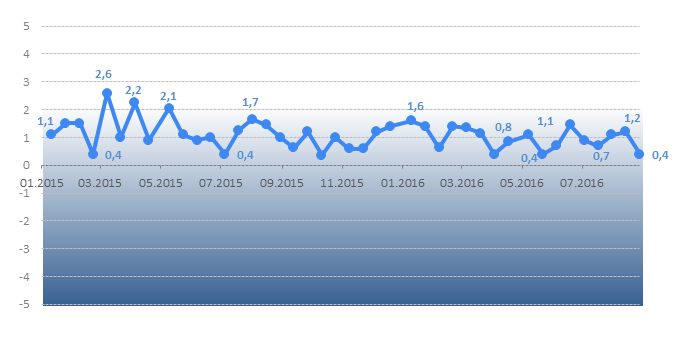The pace of reforms in Ukraine remains slow. Reform Index in the period from the last days of August through the first days of September was 0.8 points. There was progress that took place in business environment reform, public administration, and energy sectors. Nothing happened in public finance and monetary sector.
Chart 1. Reform Index dynamics*
*Reform Index team considers index value of at least 2 an acceptable pace of reform
Two of the main events of the two-week period from August 29 to September 11, which were evaluated by the iMoRe experts, were changes to the rules for household electricity consumption and the introduction of online document submission for licensing authorities. Additionally, the experts considered the organization of certain institutions, the simplification of construction projects, and organic production regulation.
Chart 2. Reform Index and its components in the current round**
** Titles of components were shortened for convenience, while their content remained the same
The Most Important Positive Developments
1. The Cabinet of Ministers destroyed the monopoly of OblEnegy companies in supplying variable-rate power meters to households +2.8 points
OblEnegy companies were the monopoly suppliers of electricity in the regions, or “oblasts”. For a long time, it was possible for households to pay different prices for electricity depending on the time of day when it was consumed. The regulations on electricity tariffs allowed for two or three different rates depending on the time of day.
With a two-rate tariff, a consumer can pay half-price of the standard cost in the off-peak period, when the energy system has the minimal load (from 11 pm to 7 am) and a full standard tariff in the other time of day. With a three-rate tariff, the price of electricity is 1.5-times standard price during the maximum load period, the full standard tariff in the semi-peak period, and 0.4-times tariff during the night, the minimal load time.
Two- and three-rate tariffs allow households to improve their energy efficiency and spend less money for their electricity. For the energy grid it means less leak periods. To use these tariffs, consumers have to provide separate electricity metering, which requires a multi-rate meter. The installation of these devices was associated with the burdensome bureaucratic procedures of OblEnergy companies, that is why the households used them very rarely, despite the tariffs’ attractiveness.
Regulation № 591 (dated August 23, 2016) introduced new rules for electricity consumption by households. The procedure of the multi-rate meters’ installation was simplified. Now the electricity suppliers must publish the technical characteristics of the meters on their web pages, and household consumers can buy meters from anyone selling them. Once the device has passed the necessary verification and has the necessary documents, electricity suppliers must take it into operation within the fixed deadlines – 3 days in cities and towns and 5 days in a countryside.
The reformer’s comment
“Multi-rate coefficients were introduced by the Commission [The National Energy and Utilities Regulatory Commission of Ukraine] more than fifteen years ago; however, in practice only industrial consumers used them. Households did not use multi-rate metering due to the low electricity prices, lack of awareness, and the OblEnergy companies’ monopoly to sell the meters as well as the associated bureaucracy. For the consumers, [the new rules] offer a real possibility to save money without bureaucracy with the fixed deadlines for OblEnergy companies. For this reason, the Commission has simplified the rules for the households, which gives the explicit benefits for all of the stakeholders:
- Consumers now have a real opportunity to save money without bureaucracy.
- The energy system more effectively optimizes load, with less demand for capacity.
- Ukraine takes a significant step toward increased energy efficiency and decreased CO2 emissions.
It was important for us to show the consumers the real possibility to save money, change the philosophy behind energy consumption, and make it more efficient and rational”.
— Dmytro Vovk, The National Energy and Utilities Regulatory Commission of Ukraine
Reform Index experts gave high marks to this measure and noted its contribution to competition development and Ukraine’s energy independence.
The Expert’s comment
“The possibility of consumers to make the own decision from whom to buy the multi-rate meter will help to open the market in this sector – the supply [of meters] will increase, and more producers will compete for customers with of the quality and prices of the devices. Additionally, it is important that OblEnergy companies now cannot require particular brands of the meters, but must put a meter into the operation within fixed deadlines – it will significantly reduce abuse and extortion of additional money, for instance, for the fast installation. Also, it gives consumers the chance to choose more affordable alternative and take advantage of night tariff.
— Olena Pavlenko, DiXiGroup
Chart 3. Value of Reform Index components and number of events August 29 – September 11, 2016
2. The Cabinet of Ministers introduced procedures for online document submission to the licensing authorities: +2 points
In Ukraine, licensing has always been a fertile ground for corruption and therefore a serious impediment for doing business. Entrepreneurs have to spend time applying for various licenses and often rewrite the documents several times at requests of officials.
By adopting Regulation № 561 dated August 23, 2016, the government introduced a system for the online submission of documents to the licensing authorities. The authority, in turn, issues an electronic license. The important new concept here is the introduction of the electronic document templates. The applicants will have explicit requirements to the documents, and the officials will not be able to give the documents back to rewrite them when the template was filled in correctly.
However, the adoption of this regulation is only the starting point. As always, a lot depends on the implementation. To make the system work, electronic templates still need to be developed.
The reformer’s comment
“This is an important step to simplify relations between businesses and governments. The procedure for online document submission and issuing enables licensing with the Integrated State Portal of Administrative Services and the associated resources. Now the portal proposes fifteen electronic services (poslugy.gov.ua/info/services). This regulation allows the Ministry of Economic Development to expand the list of the portal’s services. For full implementation of this online mechanism, some functionality needs to be added to the portal, and the electronic interaction between the portal and licensing authorities should be introduced.”
— Volodymyr Semenikhin, The Ministry of Economic Development of Ukraine
iMoRe experts ranked this measure positively and emphasized that online document submission to the licensing authorities is one more step toward deregulation.
The expert’s comment
“Application for a license is a non-transparent burdensome procedure. The licensing authorities often artificially create problems with submission of the necessary package of documents. That is why this sphere is considered as a highly corrupted one. Submitting and obtaining the licenses online will make these procedures more transparent and minimize relationships of entrepreneurs with officials. The regulation says that the government should develop electronic templates of the documents which the entrepreneurs will have to fill in to obtain a license. This template should be convenient for entrepreneurs and its requirements should be precise and unambiguous.”
— Tetyana Tyshchuk, VoxUkraine
Reform Index aims to provide a comprehensive assessment of reform efforts by Ukraine’s authorities. The Index is based on expert assessments of changes in the regulatory environment in five areas:
- Governance
- Public Finance
- Monetary system
- Business Environment
- Energy
For details please visit reforms.voxukraine.org
Attention
The author doesn`t work for, consult to, own shares in or receive funding from any company or organization that would benefit from this article, and have no relevant affiliations






